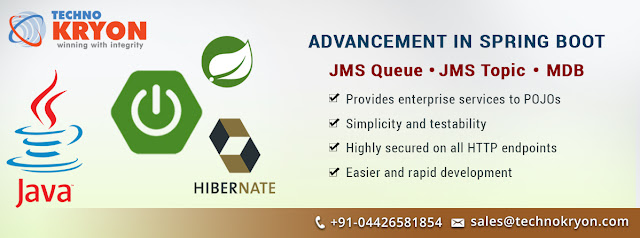OUTLINE OF JAVA WEB APPLICATION DEVELOPMENT ON SPRING
Introduction to
spring framework:
Spring is a Java framework that provides well infra for creating
Java web applications.
It handles the infrastructure, so you can only focus on your application.
Spring enables you to build
applications from POJO’s and to apply enterprise services
non-invasively to POJOs. This technology is fully used in Java SE programming
model and partially in Java EE.
 |
| Techno Kryon |
Major advantages of spring:
Make your JAVA application handle the database by your own
with JPA integration.
Handle N-number of connections without traffic by creating
micro services.
Make a simple Java message handler method without JMS APIs.
The loosely coupled system allows you integrate with any
system.
Spring boot:
Spring boot is a technology innovated by simplifying the
spring MVC framework. It contains the package of all needed tools. Spring boot
takes an opinionated approach to configuration, freeing developers from the
need to define boilerplate configuration.
Features of spring boot:
- Maven and Gradle have made the project building easier.
- Eclipse makes the development easier.
- Annotation based configuration makes the project loosely coupled.
- Inbuilt micro services handle unlimited connections.
- Repository is used to connect with entity class and relational database.
- It is a robust framework to secure applications.
- No need to configure dispatcher servlet, resource mapping and message converters etc.
Purpose of using
spring framework:
- It provides enterprise services to POJOs.
- It is simplicity and testability.
- It is highly secured by default with basic authentication on all HTTP endpoints.
- By default the JAR file will be include when combined to the tomcat server, so you can easily execute the JAR using your code.
- Spring boot provides build-in starters that help easier and rapid development.
Spring boot Security:
When you allow security for your application, a security
context will enable for each application and it stores the detail of authenticated
users. It is the defacto standard for securing spring based applications. It is
spacious and supportable for both authentication and authorization. If spring
boot with auto configuration enabled detects spring security jar on the class
path it will configure and allow security using default options.
Irresistible features
of using spring security framework:
- User authentication and authorization.
- Authorization controls based on role.
- Using authentication and authorization is easy to configure with database.
- Password encryption.
- Spring security using
Spring Boot with Rest
API:
Spring boot REST API is an architectural style. It makes developing
restful services easily. This uses HTTP protocol to send data from client to
server using JSON or XML.
Advancement in spring
boot:
JMS (Java Message Service) also called as messaging service,
is an application program interface that provides to create, send and read
message.
If you want to send
message from one application to another we need to use JMS API.
JMS Queue is messages that can be send only to one possible subscriber. And there
is no timing dependency between sender and receiver.
JMS Topic is a message send to each and every subscriber. And it has timing
dependency between publisher and subscriber.
MDB (Message Driven
Bean) asynchronously receives the message and process it. And also it receive
message like JMS.



Comments
Post a Comment